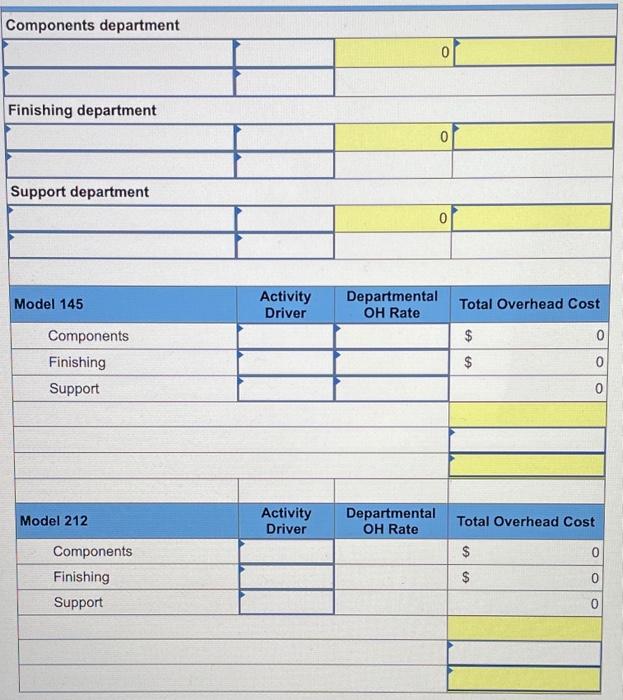Exercise 04-9 Using departmental overhead rates to assess prices LO P2 Way Cool produces two different models of air conditioners. The company produces the mechanical systems in its components department. The mechanical systems are combined with the housing assembly in its finishing department. The activities, costs, and drivers associated with these two manufacturing processes and the production support process follow. Process Activity Components Changeover Machining Setups Driver Number of batches Machine hours Number of setups Quantity 810 8,460 80 Finishing Welding Inspecting Overhead Cost $ 464,800 312,000 224,800 $1,000,000 $ 190,800 232,000 65,000 $ 487,800 $ 137,000 31,500 64,000 $ 232,500 Welding hours Number of inspections Rework orders 4,500 835 200 Rework Support Purchasing Providing space Providing utilities Purchase orders Number of units Number of units 471 4,770 4,770 Additional production information concerning its two product lines follows. Units produced Welding hours Batches Number of inspections Machine hours Setups Rework orders Purchase orders Model 145 1,700 1,000 405 475 3,150 40 160 314 Model 212 3,070 3,500 405 360 5,310 40 40 157 Required: 1. Determine departmental overhead rates and compute the overhead cost per unit for each product line. Base your overhead assignment for the components department on machine hours. Use welding hours to assign overhead costs to the finishing department Assign costs to the support department based on number of purchase orders. 2. Determine the total cost per unit for each product line if the direct labor and direct materials costs per unit are $310 for Model 145 and $150 for Model 212 3. If the market price for Model 145 is $1,325 and the market price for Model 212 is $310, determine the profit or loss per unit for each model. Components department 02 Finishing department 0 Support department 0 Model 145 Activity Driver Departmental OH Rate Total Overhead Cost Components $ 0 Finishing $ 0 Support 0 Model 212 Activity Driver Departmental OH Rate Total Overhead Cost Components $ Finishing $ 0 Support 0 Model 145 Model 212 Materials and Labor per unit Overhead cost per unit Total cost per unit Model 145 Model 212 Market price per unit Cost per unit Profit (loss) per unit











